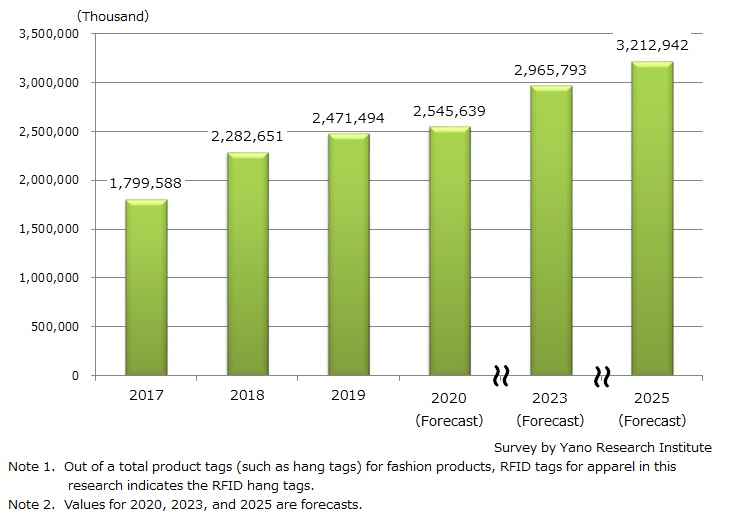No.2559
Digital Technology Strategy in Fashion Industry in Japan: Key Research Findings 2020
A Total Number of RFID Tags for Apparel for 2019 Amounts to 2,471,494 Thousand
Yano Research Institute (the President, Takashi Mizukoshi) has conducted a survey on the digital technology strategy in domestic fashion industry, and found out the trends by process and the future directions. Here, a forecast on a total number of RFID tags for apparel in Japan is announced.

Summary of Research Findings
An underlying cause of dead stock in apparel companies is the make-to-stock production. Since demand forecasting is essentially difficult for apparel products due to uncertainties involved, such as number of items, sizes, colors, patterns, trends, selling seasons and climate, makers are compelled to manufacture products for stock based on an outlook. Moreover, to reduce production cost, mass production in global supply chain has been promoted. As a result, companies are trapped in a vicious cycle of massive inventories piling up every year.
Fashion industry must optimize inventory, as their deadstock is having a negative impact on global environment by creating overuse of resources and energies as well as forced labor issues in production process, from production of materials, threads, textiles, to sewing. Since the use of digital technology is effective for reducing inventories by minimizing make-to-stock production with higher precision in demand forecasting (i.e. it is the digital transformation for fashion industry), the industry have large expectations on RFID tags for apparel.
In the long run, it is assumed that the use of RFID tags has a potential to provide end-to-end solution for supply chain management. Out of all fashion product tags (such as hang tags), an estimate on a total number of RFID hang tags distributed domestically in 2019 amounts to 2,471,494 thousand. Against the backdrop of decline in average price of RFID tags, introduction of RFID tags is becoming popular. Started by First Retailing which adopted self-checkout machines at GU stores in 2017, apparel industry is taking more interest in RFID tags.
Noteworthy Topics
Potentials of Digitization in Fashion Industry
Potentials of digitization in fashion industry by business flow are as summarized below.
<Planning/Manufacturing>
Since textiles are made of soft materials, production streamlining is difficult to achieve through automation of clothing production. Attempts to optimize inventory, like an acceleration of sample creation using 3D CAD, are already being promoted in the planning/manufacturing process. On the other hand, as there aren’t many cases of solutions for supply chain management, such as matching of enterprises to factories, future trends need to be observed.
<Sales/Sales Promotion>
With increasing efforts over the last few years, introduction of digital technology is most actively pursued in sales and sales promotion at retailers. From the apparel industry standpoint, while a range of services at brick-and-mortar stores and on websites have a lot of potential, business models for D2C (Direct to Consumer) is particularly on the rise, and therefore development of platforms to support D2C is expected to expand.
<Management>
Digital technology at the very heart of management is the pervasion and utilization of RFID tags. Until recently, introduction of RFID tags was intended just to streamline inventory taking process. Today, an objective of installing RFID is extended to more comprehensive inventory management, and the next step will be a phase in which apparel companies moves on to use RFID solutions for deployment of self-checkout systems and/or for marketing.
<Measurement>
Digital technology in measurement indicates mainly to 3D body scanning. By accumulating big data with data extracted by 3D body scanning, and utilizing it at channels like e-commerce, it may expand the market. In order to develop a drastic growth strategy, limitations in the number of (frequency of) scanning must be removed (i.e. finding a way to fix system failure, or slowing down of a system, possibly caused by bulk data repeatedly uploaded from scanners).
Research Outline
2.Research Object: Leading companies related to digital technology strategy in fashion industry
3.Research Methogology: Face-to-face interviews by our expert researchers (including online), questionnaire, and literature research
What is the RFID Tags for Apparel?
RFID (Radio-Frequency Identification) system is the automatic identification system which uses wireless communication to code information onto integrated circuit without contact.
Out of a total product tags (such as hang tags) for fashion products, RFID tags for apparel in this research indicates the RFID hang tags.
<Products and Services in the Market>
RFID tags for apparel, RFID inlay (IC chip/antenna of RFID tags)
Published Report
Contact Us
The copyright and all other rights pertaining to this report belong to Yano Research Institute.
Please contact our PR team when quoting the report contents for the purpose other than media coverage.
Depending on the purpose of using our report, we may ask you to present your sentences for confirmation beforehand.